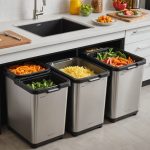Maintaining clean draft beer lines is essential for both flavor and hygiene in your craft brewery. Neglected lines can lead to off-flavors and unwanted bacteria, impacting customer satisfaction. Implementing a proper cleaning routine not only preserves the quality of your brew but also extends the lifespan of your equipment. This guide provides actionable tips tailored specifically for craft brewers looking to master this vital aspect of brewery operations. Embrace these practices and ensure your beer is always served fresh and at its best.
Importance of Cleaning Draft Beer Lines
Maintaining draft beer line cleaning is crucial for preserving the quality of beer. Dirty lines can drastically alter the taste, leading to unpleasant experiences for customers. Contamination in beer lines often results from yeast, mold, and bacteria build-up. This not only affects flavor but can also pose health risks.
This might interest you : Discover the Hottest Innovations in Gourmet Burger Presentation Trends
Impact of Dirty Lines on Beer Taste
Dirty lines can impart off-flavors, such as sourness or mustiness, to the beer. Regular cleaning ensures that the beer retains its intended taste profile, enhancing customer satisfaction and loyalty.
Contamination Rates and Prevention
Statistics reveal that unclean lines can have contamination rates as high as 37%. Regular draft beer line cleaning is essential to prevent such high rates of contamination. Implementing a consistent cleaning schedule can significantly reduce these risks.
Also read : Mastering Beer Tap Rotation: Top Strategies for Curating Craft Brews in Your Bar
Long-term Benefits for Breweries
- Enhanced Beer Quality: Clean lines ensure the beer tastes as the brewer intended.
- Customer Satisfaction: Patrons are more likely to return when they enjoy their drinks.
- Operational Efficiency: Clean lines reduce the likelihood of costly repairs and replacements.
Maintaining a routine cleaning schedule is not just about hygiene; it's about safeguarding the brewery's reputation and ensuring long-term success. Regular draft beer line cleaning is a small investment with substantial returns.
Recommended Cleaning Products
Selecting the right products ensures effective maintenance.
Types of Cleaning Solutions
Choosing the right cleaning products for draft systems is essential. Solutions specifically designed for beer line cleaning ensure thorough sanitation without damaging the equipment. Alkaline-based cleaners are effective for removing organic residues like yeast and mold. Acid-based cleaners, on the other hand, excel at eliminating mineral deposits. Both types are crucial for maintaining clean lines.
Recommended Brands
Several brands stand out for their effectiveness. Some of the top beer line cleaners include:
- BLC (Beer Line Cleaner)
- KegWorks Beer Line Cleaning Solution
- Micro Matic Beer Line Cleaner
These brands are praised for their powerful formulations that tackle stubborn build-up, ensuring lines remain pristine. Using reputable brands guarantees that the products are food-safe, preventing contamination and preserving beer quality.
Importance of Food-Safe Products
Ensuring that cleaning solutions are food-safe is paramount. Products specifically labeled for use in food and beverage environments protect both the consumer and the equipment. This focus on safety helps maintain the integrity of the beer, ensuring it tastes as intended, and supports customer satisfaction. Always prioritize sanitizers that meet industry standards for safety and performance.
Step-by-Step Cleaning Process
Thorough cleaning of draft beer lines is essential for maintaining beer quality. Below are the detailed steps involved in the draft line cleaning process.
Preparation for Cleaning
Before starting the cleaning process, gather all necessary equipment: a cleaning canister, hose, and appropriate cleaning solutions. Ensure safety gear such as gloves and goggles are worn to protect against chemical exposure. Disconnect the kegs and release the pressure from the lines. This preparation step is crucial for a successful draft line cleaning process.
Cleaning the Lines
Begin by filling the cleaning canister with the selected cleaning solution. Connect the canister to the beer lines. Pump the solution through the lines, allowing it to circulate for the recommended time as per the manufacturer's instructions. This step ensures thorough cleaning of all residues and contaminants, maintaining the integrity of the draft line cleaning process.
Final Rinsing and Sanitizing
After cleaning, flush the lines with clean water to remove any residual cleaning solution. Follow with a sanitizing rinse using a food-safe sanitizer to ensure the lines are safe for use. Proper rinsing and sanitizing are vital to complete the draft line cleaning process, ensuring the beer lines are pristine and ready for the next use.
Recommended Cleaning Frequency
Ensuring optimal draft system upkeep is essential for quality beer.
Guidelines for Cleaning Frequency
The cleaning frequency of beer lines is a pivotal aspect of maintaining a draft system. Industry standards suggest that beer lines should be cleaned every two weeks. However, this schedule can vary based on specific factors. For instance, bars with a high volume of beer served might require more frequent cleaning to ensure the lines remain uncontaminated.
Factors Influencing Frequency
Several elements influence the maintenance schedule for beer line cleaning. The type of beer, the system's length, and environmental conditions all play a role. A pub serving diverse beer types, including those with high yeast content, may need to clean more often.
- Volume of beer served
- Type of beer dispensed
- Environmental conditions
Consequences of Neglect
Neglecting a regular cleaning frequency can lead to severe consequences. Over time, contaminants build up, affecting the taste and safety of the beer. This neglect can result in customer dissatisfaction and potential health risks. Therefore, adhering to a strict maintenance schedule is crucial for preserving both the quality of the beer and the reputation of the establishment.
Troubleshooting Common Issues
Understanding the complexities of draft line issues is essential for maintaining beer quality.
Identifying Signs of Dirty Lines
Recognizing signs of dirty lines is the first step in troubleshooting beer lines. Common indicators include off-flavors, such as sourness or mustiness, and excessive foam. These symptoms often suggest a need for immediate attention to prevent further complications. Regular inspection can help identify these common problems early.
Solutions for Common Problems
Addressing troubleshooting beer lines involves practical solutions. For off-flavors, a thorough cleaning of the draft lines is recommended. If foam issues persist, check for temperature inconsistencies or pressure imbalances. Ensure the draft system is calibrated correctly to maintain optimal performance.
- Off-flavors: Clean lines thoroughly
- Foam issues: Check temperature and pressure
- Regular maintenance: Prevents recurring problems
When to Seek Professional Help
In some cases, draft line issues may require professional intervention. Persistent problems, despite regular maintenance, indicate deeper issues within the system. Consulting a professional can provide specialized solutions, ensuring the system operates efficiently. It's crucial to know when to seek expert advice to safeguard beer quality and customer satisfaction.
Best Practices to Prevent Contamination
Effective strategies for maintaining pristine beer lines.
Techniques for Minimizing Contamination Risk
Implementing robust prevention strategies is vital for maintaining clean beer lines. Regular inspection of equipment can identify potential contamination sources early. Using food-safe, industry-standard cleaning solutions ensures thorough sanitation without damaging the system.
Importance of Proper Line Installation and Maintenance
Proper beer line maintenance starts with correct installation. Ensuring that lines are installed without kinks or unnecessary bends reduces areas where contaminants can accumulate. Regular maintenance checks should be scheduled to inspect for wear and tear.
- Install lines correctly to prevent contamination
- Schedule frequent maintenance checks
- Use food-safe cleaning solutions
Best Practices for Staff Training and Awareness
Staff training is crucial in contamination prevention. Employees should be well-versed in recognizing signs of contamination, such as off-flavors or excessive foam. Regular workshops can keep staff updated on the latest beer line maintenance techniques.
"An informed team is the first line of defense against contamination."
By prioritizing these prevention strategies, establishments can ensure the quality and safety of their beer, enhancing customer satisfaction and loyalty. Consistent training and maintenance are key components in safeguarding the reputation of any bar or brewery.
Visual Aids and Diagrams
Enhancing understanding through visual representation.
Benefits of Using Visual Aids in Training Staff
Incorporating visual aids in training enhances comprehension and retention. Cleaning diagrams provide clear, step-by-step guidance, making complex procedures more accessible. Visual guides simplify the instructional aids, reducing errors during the cleaning process. By offering a visual reference, staff can better understand and execute tasks, ensuring consistency in cleaning processes.
Examples of Diagrams for Cleaning Processes
Cleaning diagrams can illustrate the entire cleaning cycle, from preparation to final rinsing. These diagrams often include labeled sections for each step, such as disconnecting kegs, applying solutions, and rinsing. A well-designed visual guide can serve as a quick reference, helping staff follow the correct procedures without confusion.
- Preparation: Equipment setup
- Application: Solution flow
- Rinsing: Final steps
How to Create Effective Instructional Materials
Creating effective instructional aids involves clarity and simplicity. Use clear labels and concise explanations in visual guides. Incorporate color-coding to differentiate steps and highlight critical actions. Ensure that the cleaning diagrams are easily accessible to all staff members, possibly through digital platforms or printed materials.
"A picture is worth a thousand words, especially in training."
Case Studies on Beer Line Maintenance
Insights from successful brewery cleaning practices.
Success Stories from Breweries
Several breweries have transformed their operations through improved beer line maintenance. A notable case is a mid-sized brewery in Colorado that reported a 15% increase in customer satisfaction after implementing a rigorous cleaning schedule. This success underscores the importance of regular cleaning practices in maintaining beer quality.
Data on Beer Quality Improvements
Data from these case studies illustrate significant improvements in beer quality post-cleaning. For instance, one brewery documented a reduction in off-flavors by 40% after adopting enhanced cleaning effectiveness strategies. Such results highlight the tangible benefits of consistent beer line maintenance.
| Brewery Name | Quality Improvement (%) | Customer Satisfaction Increase (%) |
|---|---|---|
| Brewery A | 40 | 15 |
| Brewery B | 35 | 10 |
Lessons Learned and Recommendations
These case studies offer valuable lessons. One recommendation is to train staff thoroughly on cleaning practices. Another is to invest in high-quality cleaning products for better results. As one brewery manager noted, "The key to our success was understanding the critical role of beer line maintenance in preserving the integrity of our product."
By adopting these insights, breweries can enhance their operations, ensuring their beer remains top-notch and customers satisfied.
Conclusion and Additional Resources
Insights and guidance for maintaining exceptional beer quality.
Key Takeaways from the Guide
Maintaining draft beer line cleanliness is vital for preserving beer quality and ensuring customer satisfaction. The guide emphasizes the importance of regular cleaning, using food-safe products, and adhering to a consistent maintenance schedule. Implementing best practices not only enhances beer taste but also extends the lifespan of equipment, reducing long-term costs.
Further Reading and Resources
For those seeking to delve deeper into draft beer line maintenance, numerous resources and guides are available. These materials offer comprehensive insights into cleaning techniques, troubleshooting common issues, and optimizing beer line maintenance practices. Investing time in further education can significantly improve the quality of service and product offered by any brewery or bar.
Prioritizing Line Cleanliness
Ensuring line cleanliness is not just a routine task but a commitment to quality. Prioritizing this aspect of brewery maintenance safeguards the reputation of the establishment and enhances customer loyalty.
- Regular cleaning
- Use of high-quality, food-safe products
- Continuous staff training
"The integrity of your beer reflects the integrity of your line maintenance practices."
By focusing on these elements, establishments can ensure that they consistently deliver the highest quality beer, meeting both industry standards and customer expectations.











